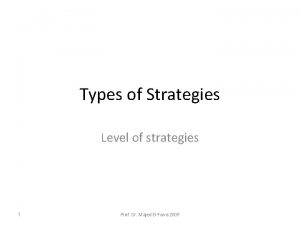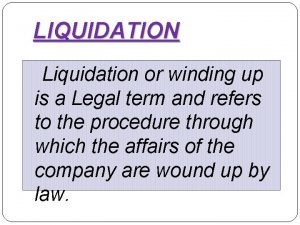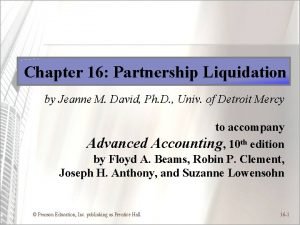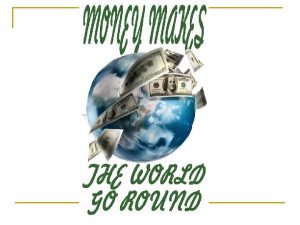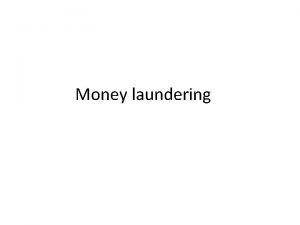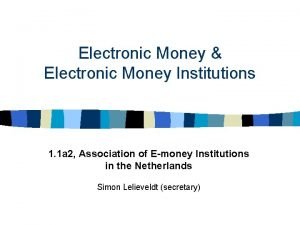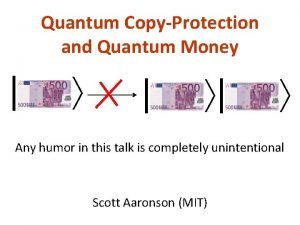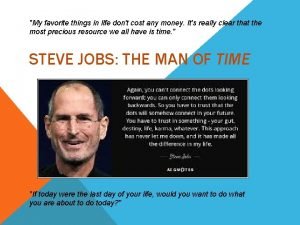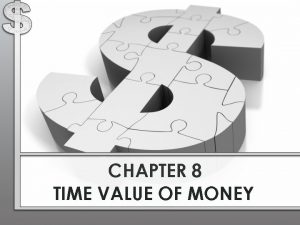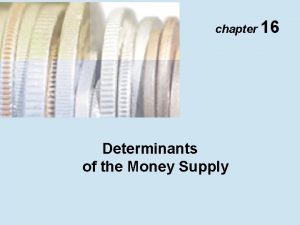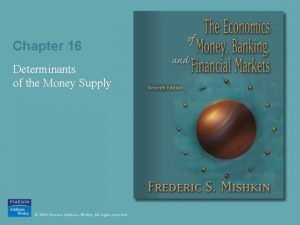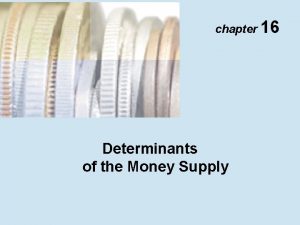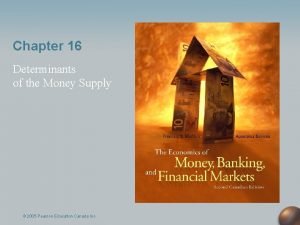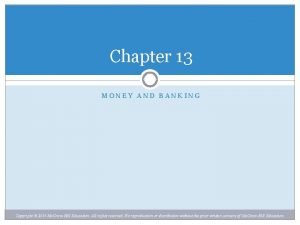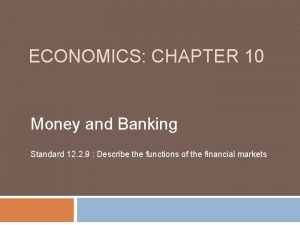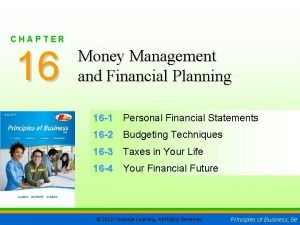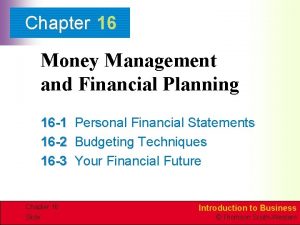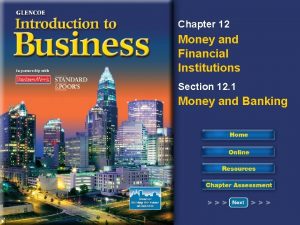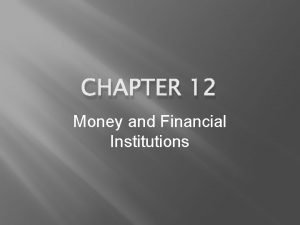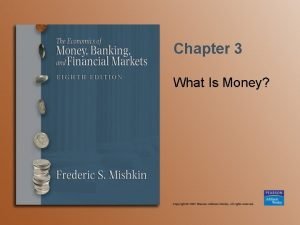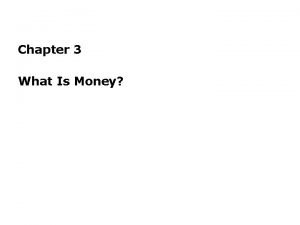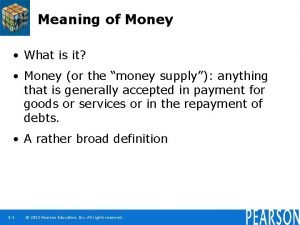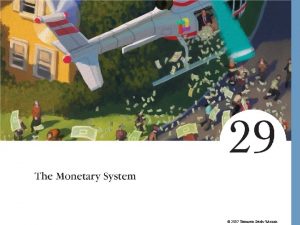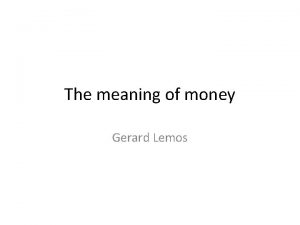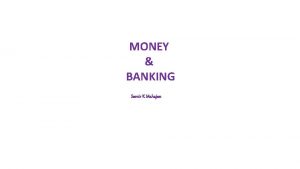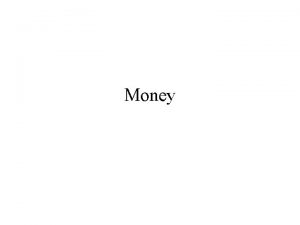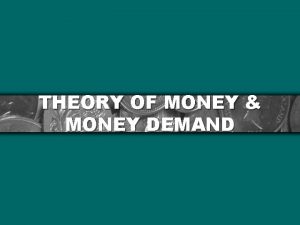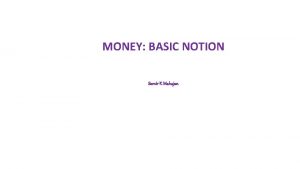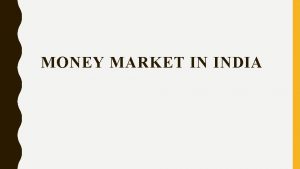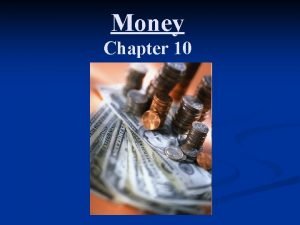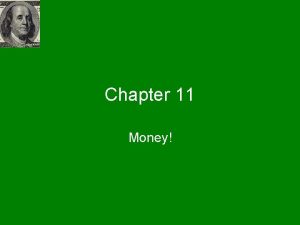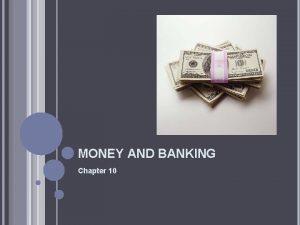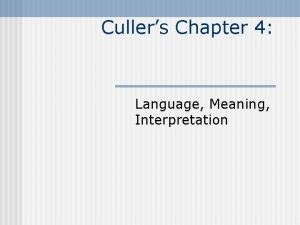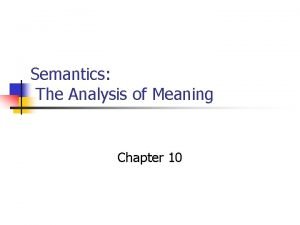Chapter 3 What Is Money Meaning of Money



























- Slides: 27

Chapter 3 What Is Money?

Meaning of Money • money (also referred to as the money supply) as anything that is generally accepted in payment for goods or services or in the repayment of debts. • Money and Currency: when most people talk about money, they’re talking about currency (paper money and coins). To define money merely as currency is too narrow definition of money. Other means are also accepted as payment for purchases. • Money and Wealth: money in the form of currency, demand deposits, and other items that are used to make purchases and wealth (the total collection of pieces of property that serve to store value). 3 -2 © 2013 Pearson Education, Inc. All rights reserved.

Meaning of Money • Money and Income: people also use the word money to describe what economists call income. Income is a flow of earnings per unit of time. Money, by contrast, is a stock. 3 -3 © 2013 Pearson Education, Inc. All rights reserved.

Functions of Money 1. Medium of Exchange: i. e. , it is used to pay for goods and services. Using money as medium of exchange promotes economic efficiency • Look at a barter economy, one without money, in which goods and services are exchanged directly for other goods and services. • In a barter economy, transaction costs are high because people have to satisfy a “double coincidence of wants”. Money - reduces transaction costs, - Promotes specialization (why specialization is a problem in a barter economy? ) 3 -4 © 2013 Pearson Education, Inc. All rights reserved.

Functions of Money • As a medium of exchange money promotes economic efficiency by: - eliminating much of the time spent exchanging goods and services. - allowing people to specialize in what they do best • For a commodity to function effectively as money, it has to meet several criteria: (1) It must be easily standardized, making it simple to ascertain its value; (2) It must be widely accepted; 3 -5 © 2013 Pearson Education, Inc. All rights reserved.

Functions of Money (3) It must be divisible, so that it is easy to “make change”; (4) It must be easy to carry; (5) It must not deteriorate quickly • Most of these criteria are met by gold. 3 -6 © 2013 Pearson Education, Inc. All rights reserved.

Functions of Money 2. • • • 3 -7 Unit of Account: used to measure value in the economy. To see how this function is important, let us consider a barter economy: If the number of goods=3, No. of prices=3 If the number of goods=10, No. of prices=45 If the number of goods=100, No. of prices=4950 If the number of goods=1000, No. of prices=499500 Use this formula: (N(N-1))/2 Where N = number of goods © 2013 Pearson Education, Inc. All rights reserved.

Functions of Money • The solution to the problem is to introduce money into the economy and have all prices quoted in terms of units of that money. This substantially reduces the number of prices, e. g. , if the No. of goods = 10, No. of prices=10 and so on. • using money as a unit of account reduces transaction costs in an economy by reducing the number of prices that need to be considered. 3 -8 © 2013 Pearson Education, Inc. All rights reserved.

Functions of Money • 3. Store of Value: is used to save purchasing power from the time income is received until the time it is spent. • Money is not unique as a store of value, other assets have advantages over money as a store of value: - They often pay the owner a higher interest rate than money, - experience price appreciation - deliver services • Why do people hold money at all? • Money is the most liquid asset. Liquidity is the relative ease and speed with which an asset can be converted into a medium of exchange. 3 -9 © 2013 Pearson Education, Inc. All rights reserved.

Functions of Money • Other assets involve transaction costs when they are converted into money. • How good a store of value money is depends on the price level. when the price level is increasing (inflation), money loses value. • extreme inflation, known as hyperinflation, in which the inflation rate exceeds 50% per month. • Zimbabwe is an example of recent hyperinflations. 3 -10 © 2013 Pearson Education, Inc. All rights reserved.

Evolution of the Payments System • The payments system is the method of conducting transactions in the economy. • 1. Commodity Money: Money made up of precious metals or another valuable commodity. • Problems: - very heavy - hard to transport from one place to another, especially for large purchases. 3 -11 © 2013 Pearson Education, Inc. All rights reserved.

Evolution of the Payments System • 2. Fiat Money: paper currency decreed by governments as legal tender but not convertible into coins or precious metals. • Advantages: - being much lighter than coins or precious metals • Problems: - accepted only if there is some trust in the authorities who issue it. - easily stolen - expensive to transport in large amounts because of their bulk. 3 -12 © 2013 Pearson Education, Inc. All rights reserved.

Evolution of the Payments System • 3. Checks: an instruction from you to your bank to transfer money from your account to someone else. • Advantages: - Minimize the movement of money, payments that cancel each other can be settled by canceling the checks. - reduce the transportation costs associated with the payments system and improve economic efficiency. – can be written for any amount up to the balance in the account, making transactions for large amounts much easier – loss from theft is greatly reduced, – provide convenient receipts for purchases 3 -13 © 2013 Pearson Education, Inc. All rights reserved.

Evolution of the Payments System • Problems: – It takes time to get checks from one place to another. – the paper shuffling required to process checks is costly, estimated to be $10 billion a year in USA. • 4. Electronic Payment: make payments electronically over the internet. • Advantages: – save the cost – Require little effort – recurring bills can be automatically deducted from the bank account 3 -14 © 2013 Pearson Education, Inc. All rights reserved.

Evolution of the Payments System • E-Money: money that exists only in electronic form. – 1. Debit cards, enable consumers to purchase goods and services by electronically transferring funds directly from their bank accounts to a merchant’s account, e. g. , K-Net card in Kuwait. – 2. Credit cards are now often becoming faster to use than cash, e. g. , Visa and Master. Card. – stored-value card, like a prepaid phone card, sophisticated cards are now known as Smart cards, allows cards to be loaded with digital cash from the owner’s bank account whenever needed. Smart cards can be loaded from ATM machines, personal computers with a smart card reader, or specially equipped telephones. 3 -15 © 2013 Pearson Education, Inc. All rights reserved.

Evolution of the Payments System • 3. e-cash: accounts with a bank that has links to the internet and then has the e-cash transferred to your PC, you then can be using the cash to pay for your purchases. • What makes an asset money is that people believe it will be accepted by others when making payment. • this behavioral definition does not tell us exactly what assets in our economy should be considered money. • To measure money, we need a precise definition that tells us exactly what assets should be included. 3 -16 © 2013 Pearson Education, Inc. All rights reserved.

Are We Headed for a Cashless Society? • Predictions of a cashless society have been around for decades, but they have not come to fruition • Although e-money might be more convenient and efficient than a payments system based on paper, several factors work against the disappearance of the paper system • Still, the use of e-money will likely still increase in the future 3 -17 © 2013 Pearson Education, Inc. All rights reserved.

Measuring Money • The Central Bank of Kuwait’s Monetary • Aggregates. • M 1 (most liquid assets) = currency in circulation with the public + sight deposits (private deposits in KWDs) + other checkable deposits. • M 2 (adds to M 1 other assets that are not so liquid) = M 1 + Quasi money (saving deposits in KWDs + time deposits in KWDs). • M 3 (adds to M 2 somewhat less liquid assets) = M 2 + deposits in non-bank financial institutions. 3 -18 © 2013 Pearson Education, Inc. All rights reserved.

Monetary Aggregates (USA) M 1 (4) M 2 (4+3) Currency Traveler’s Checks Demand Deposits Other Check. Dep Small Den. Dep. Savings and MM Money Market Mutual Funds Shares M 3 (4+3+4) 3 -19 © 2013 Pearson Education, Inc. All rights reserved.

Measuring Money(USA) • How do we measure money? Which particular assets can be called “money”? • Construct monetary aggregates using the concept of liquidity: • M 1 (most liquid assets) = currency + traveler’s checks + demand deposits + other checkable deposits. 3 -20 © 2013 Pearson Education, Inc. All rights reserved.

Measuring Money (USA) • M 2 (adds to M 1 other assets that are not so liquid) = M 1 + small denomination time deposits + savings deposits and money market deposit accounts + money market mutual fund shares. 3 -21 © 2013 Pearson Education, Inc. All rights reserved.

Table 1 Measures of the Monetary Aggregates (USA) 3 -22 © 2013 Pearson Education, Inc. All rights reserved.

M 1 vs. M 2(USA) • Does it matter which measure of money is considered? • M 1 and M 2 can move in different directions in the short run (see figure). • Conclusion: the choice of monetary aggregate is important for policymakers. 3 -23 © 2013 Pearson Education, Inc. All rights reserved.

Figure 1 Growth Rates of the M 1 and M 2 Aggregates, 1960– 2011(USA) Sources: Federal Reserve Economic Database (FRED); Federal Reserve Bank of Saint Louis; http: //research. stlouisfed. org/fred 2/categories/25 3 -24 © 2013 Pearson Education, Inc. All rights reserved.

FYI Where All the U. S. Dollars? • The more than $2, 000 of U. S. currency held person in the United States is a surprisingly large number • Where all these dollars and who is holding them? – Criminals – Foreigners 3 -25 © 2013 Pearson Education, Inc. All rights reserved.

commodity money, e-cash, fiat money, income, M 1, M 3, monetary aggregates, smart card, unit of account, 3 -26 © 2013 Pearson Education, Inc. All rights reserved. currency, electronic money (e-money), hyperinflation, liquidity, M 2, medium of exchange payments system, store of value, wealth,

3 -27 © 2013 Pearson Education, Inc. All rights reserved.
 Money money money team
Money money money team Gatsby physical description
Gatsby physical description Money smart money match
Money smart money match Money on money multiple
Money on money multiple Gatsby historical background
Gatsby historical background Tom buchanan character traits
Tom buchanan character traits Liquidated money meaning
Liquidated money meaning Liquidated money meaning
Liquidated money meaning Value of money meaning
Value of money meaning Chapter 4 partnership liquidation
Chapter 4 partnership liquidation Who is the poet of money madness
Who is the poet of money madness Does money make the world go round
Does money make the world go round Placement anti money laundering
Placement anti money laundering Electronic money meaning
Electronic money meaning Quantum of money meaning
Quantum of money meaning My favorite things in life don't cost any money
My favorite things in life don't cost any money Chapter 8 time value of money answer key
Chapter 8 time value of money answer key Velocity formula econ
Velocity formula econ Chapter 16 determinants of the money supply
Chapter 16 determinants of the money supply Chapter 16 determinants of the money supply
Chapter 16 determinants of the money supply Chapter 16 determinants of the money supply
Chapter 16 determinants of the money supply The formula for the simple deposit multiplier is
The formula for the simple deposit multiplier is Chapter 13 money and the banking system answers
Chapter 13 money and the banking system answers Chapter 10 money and banking
Chapter 10 money and banking Chapter 16 money management and financial planning
Chapter 16 money management and financial planning Chapter 16 money management and financial planning
Chapter 16 money management and financial planning Chapter 12 money and financial institutions
Chapter 12 money and financial institutions Chapter 12 money and financial institutions
Chapter 12 money and financial institutions






